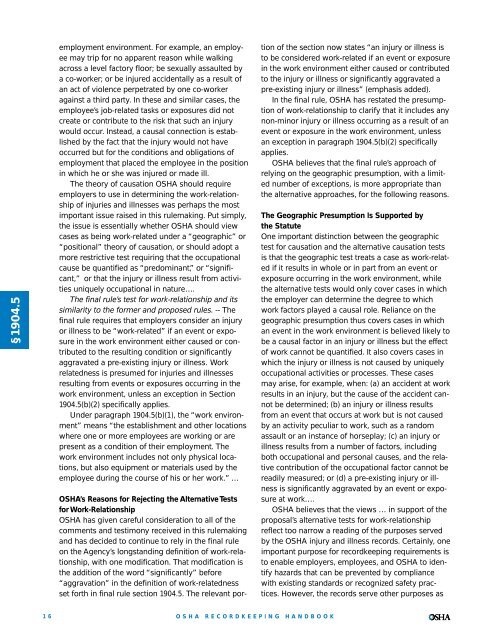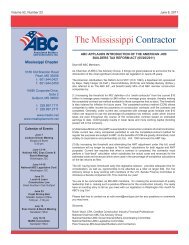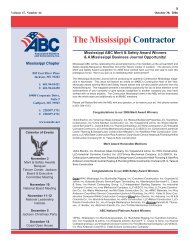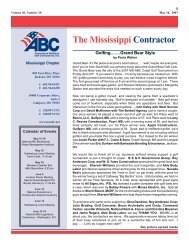OSHA Recordkeeping Handbook - Msabc.net
OSHA Recordkeeping Handbook - Msabc.net
OSHA Recordkeeping Handbook - Msabc.net
Create successful ePaper yourself
Turn your PDF publications into a flip-book with our unique Google optimized e-Paper software.
§1904.5employment environment. For example, an employeemay trip for no apparent reason while walkingacross a level factory floor; be sexually assaulted bya co-worker; or be injured accidentally as a result ofan act of violence perpetrated by one co-workeragainst a third party. In these and similar cases, theemployee’s job-related tasks or exposures did notcreate or contribute to the risk that such an injurywould occur. Instead, a causal connection is establishedby the fact that the injury would not haveoccurred but for the conditions and obligations ofemployment that placed the employee in the positionin which he or she was injured or made ill.The theory of causation <strong>OSHA</strong> should requireemployers to use in determining the work-relationshipof injuries and illnesses was perhaps the mostimportant issue raised in this rulemaking. Put simply,the issue is essentially whether <strong>OSHA</strong> should viewcases as being work-related under a “geographic” or“positional” theory of causation, or should adopt amore restrictive test requiring that the occupationalcause be quantified as “predominant,” or “significant,”or that the injury or illness result from activitiesuniquely occupational in nature….The final rule’s test for work-relationship and itssimilarity to the former and proposed rules. -- Thefinal rule requires that employers consider an injuryor illness to be “work-related” if an event or exposurein the work environment either caused or contributedto the resulting condition or significantlyaggravated a pre-existing injury or illness. Workrelatedness is presumed for injuries and illnessesresulting from events or exposures occurring in thework environment, unless an exception in Section1904.5(b)(2) specifically applies.Under paragraph 1904.5(b)(1), the “work environment”means “the establishment and other locationswhere one or more employees are working or arepresent as a condition of their employment. Thework environment includes not only physical locations,but also equipment or materials used by theemployee during the course of his or her work.” …<strong>OSHA</strong>’s Reasons for Rejecting the Alternative Testsfor Work-Relationship<strong>OSHA</strong> has given careful consideration to all of thecomments and testimony received in this rulemakingand has decided to continue to rely in the final ruleon the Agency’s longstanding definition of work-relationship,with one modification. That modification isthe addition of the word “significantly” before“aggravation” in the definition of work-relatednessset forth in final rule section 1904.5. The relevant portionof the section now states “an injury or illness isto be considered work-related if an event or exposurein the work environment either caused or contributedto the injury or illness or significantly aggravated apre-existing injury or illness” (emphasis added).In the final rule, <strong>OSHA</strong> has restated the presumptionof work-relationship to clarify that it includes anynon-minor injury or illness occurring as a result of anevent or exposure in the work environment, unlessan exception in paragraph 1904.5(b)(2) specificallyapplies.<strong>OSHA</strong> believes that the final rule’s approach ofrelying on the geographic presumption, with a limitednumber of exceptions, is more appropriate thanthe alternative approaches, for the following reasons.The Geographic Presumption Is Supported bythe StatuteOne important distinction between the geographictest for causation and the alternative causation testsis that the geographic test treats a case as work-relatedif it results in whole or in part from an event orexposure occurring in the work environment, whilethe alternative tests would only cover cases in whichthe employer can determine the degree to whichwork factors played a causal role. Reliance on thegeographic presumption thus covers cases in whichan event in the work environment is believed likely tobe a causal factor in an injury or illness but the effectof work cannot be quantified. It also covers cases inwhich the injury or illness is not caused by uniquelyoccupational activities or processes. These casesmay arise, for example, when: (a) an accident at workresults in an injury, but the cause of the accident cannotbe determined; (b) an injury or illness resultsfrom an event that occurs at work but is not causedby an activity peculiar to work, such as a randomassault or an instance of horseplay; (c) an injury orillness results from a number of factors, includingboth occupational and personal causes, and the relativecontribution of the occupational factor cannot bereadily measured; or (d) a pre-existing injury or illnessis significantly aggravated by an event or exposureat work….<strong>OSHA</strong> believes that the views … in support of theproposal’s alternative tests for work-relationshipreflect too narrow a reading of the purposes servedby the <strong>OSHA</strong> injury and illness records. Certainly, oneimportant purpose for recordkeeping requirements isto enable employers, employees, and <strong>OSHA</strong> to identifyhazards that can be prevented by compliancewith existing standards or recognized safety practices.However, the records serve other purposes as16<strong>OSHA</strong> RECORDKEEPINGHANDBOOK







